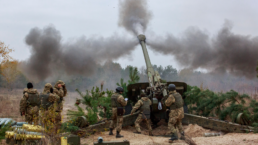There is already pressure to get involved if there is a full-scale invasion, but our history with proxy wars is littered with folly.
By Ted Galen Carpenter, Responsible Statecraft
The increasingly volatile situation involving Russia and Ukraine has the entire world on edge. Vladimir Putin’s decision to recognize the “independence” of two separatist regions in Ukraine, and especially his deployment of Russian “peacekeeping” troops to those regions, has dramatically escalated tensions. Although a full-scale invasion and occupation of Ukraine is not certain, even that scenario cannot be ruled out.
One point is clear though: the West’s proclaimed commitment to support Ukraine’s sovereignty and territorial integrity does not include U.S. or NATO military forces. Biden has confirmed that he “would not send American serviceman to fight in Ukraine” under any circumstances. Other NATO leaders have adopted similar positions of military restraint. Even if a larger invasion takes place, the West’s response likely will focus on imposing new, harsher economic sanctions on Moscow.

U.S. and Western officials are grappling with the embarrassing fact that they oversold their backing for Kyiv and now face the reality that Putin has called their bluff with an invasion and occupation of at least some of Ukraine’s territory. Consequently, they are scrambling for an option that would go beyond merely implementing more economic sanctions — a move that might hurt the global economy as much as it would inflict pain on Russia. The current front-runner for a more robust response is a scheme to fund and arm Ukrainian fighters to mount a resistance to a Russian occupation. Indeed, there are news reports that CIA operatives already are busily training Ukrainian paramilitary units.
Recent Posts
Politicians Are Betraying Gen Z On Climate
July 10, 2025
Take Action Now While Gen-Zers thrift, knit, crochet, and find other ways to reduce our footprints, Trump and the GOP are greenlighting more climate…
Trump’s Deportation Threat Against Zohran Mamdani Is Shameful
July 10, 2025
Take Action Now In only half a year of Donald Trump’s presidency, he and his allies have turned deportation into an explicitly political threat…
Teachers Union Votes To Cut Ties To The Anti-Defamation League
July 10, 2025
Take Action Now In a momentous vote, the National Education Association voted to cut all ties with the Anti-Defamation League. The reason? “Despite…
2025 War Abolisher Awards Go To Albanese, Nader, Waters
July 9, 2025
Take Action Now The purpose of the awards is to honor and encourage support for those working to abolish the institution of war itself.By World…




